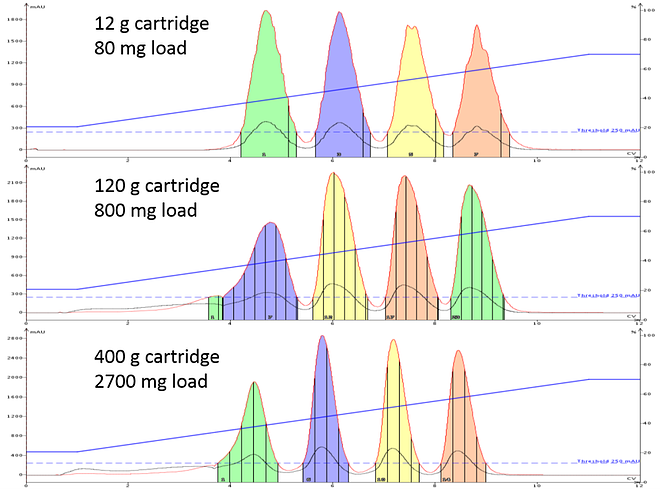Jan 23, 2023 3:07:21 PM
How do I determine loading capacity in reverse phase flash column chromatography?
By Bob Bickler

As the popularity of prep-scale, reversed-phase flash chromatography increases, so does the frequency that I get asked this question, "How do I determine loading capacity in reversed-phase flash chromatography?"
In the world of HPLC, loading capacity isn’t normally a concern as it is primarily an analytical technique. In the synthetic organic chemistry world, most purification is performed with silica gel where flash column purification methods are developed and loading capacity estimated from TLC data. However, when normal-phase flash does not work and reversed-phase flash is needed, the question of how to determine reversed-phase loading capacity comes up.
In this post I will attempt to provide some guidelines to help you understand and determine reversed-phase flash chromatography loading capacity.
In a previous post I discussed reversed-phase flash method development. In that post I talked about using an HPLC column packed with the same media as your reversed-phase flash cartridge (e.g. a scaling column) to perform method development. Using this approach you can perform an empirical loading study to determine the amount of crude sample you can load on the scaling column. This result becomes your loading capacity represented as a percentage (grams of crude/grams of media in the column x 100). The point where the empirical loading study should stop is where your target compound's purity result no longer meets your needs.
Use an Analytical HPLC with a Scaling Column
A 4.6 x 250 mm scaling column contains approximately 2.5 grams of C18 media. If, for example, you were able to get a suitable separation on your scaling column with a load of 0.0025 grams (2.5 mg) of crude sample, your loading capacity is 0.1%. This value can be extrapolated to your larger flash cartridge since the same media particle size was used.
Use a Small Reversed-phase Flash Column
If you do not have an HPLC and a scaling column, you can accomplish the load study on a small flash cartridge with the media you expect to use. Though this approach uses more solvent than the HPLC, its loading study results will be more accurate only due to the fact that the HPLC UV detector is an order of magnitude more sensitive and can provide a lower load estimate than what may actually be possible on a flash reversed-phase cartridge.
How to Determine Loading Capacity
To measure the load capacity, load increasingly larger amounts of your sample in the weakest possible solvent until your compound of interest no longer has the purity you need. Determine the loading capacity by dividing the mass of the sample (in grams) by the mass of the media bed in the column (also in grams). This ratio is the loading expressed as a percentage.
Once you determine the loading capacity (in grams or milligrams), cut it by 10% and repeat the test. If your target’s purity is where you need it to be, you are done determining loading capacity and ready for purification on the appropriate size cartridge.
Scaling up
Take the mass of material that you want to purify and use the loading capacity percent determined above to choose an appropriately sized column. Just keep the same sample loading percent and concentration and scale-up the purification on the larger cartridge which is based on the amount of crude you need to purify.
For example, suppose you have determined that your load capacity or load factor at a small scale is 1% (load factor 0.01) and you have 3 grams of crude material to purify. Use the equation below to determine the column size needed to purify the 3 grams.
Column size needed = amount of crude/load factor
or
Column size needed = 3 grams/0.01 = 300 grams
So, with a 1% load determined and the need to purify 3 grams of crude, a column or cartridge with at least 300 grams of the same reversed-phase media is required.
To see how this works you can look at Figure 1. It shows the linear scale-up of a four paraben mix (methyl, ethyl, propyl, and butyl) at a ratio of 1:1:1:1 (0.1 g/mL total concentration) using C18 flash cartridges (Biotage® SNAP KP-C18-HS) from 80 mg to 2.7 grams.
 Figure 1. After determining load capacity on a small cartridge (top), scale up is linear based on the amount of media in the cartridge.
Figure 1. After determining load capacity on a small cartridge (top), scale up is linear based on the amount of media in the cartridge.
Loading capacity, regardless of whether the chromatography is reversed- or normal-phase, will always be dependent on sample complexity. For a complex sample with multiple compounds the determining factor for complexity is how well separated your target compound is from its nearest eluting neighbors. In the example above, the four compounds are separated easily allowing for a loading of nearly 0.7%, which is maintained, and even slightly improved upon, during linear scale-up.
Reversed-phase versus Normal-phase
Because un-bonded silica has considerably more chromatographically available surface area than bonded silica (e.g. C18) it has more loading capacity. This is usually as much as 10 times more loading capacity than reversed-phase media. Where bare silica typically provides 1% to 10% loading capacity, reversed-phase typically provides 0.1% to 1% loading capacity.
Interested in reading more about reversed-phase flash chromatography? Click the link below.
Published: Jan 23, 2023 3:07:21 PM

